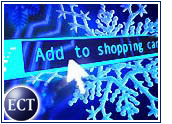
Having long focused on the potential of a high-performance Internet, Nortel Networks (NYSE: NT) now also relies on the Web to gain traction among customers and ramp up its brand visibility.
The company is developing marketing content that highlights its initiatives, including Internet protocol technologies and m-commerce services.
Amid a harsh sector-wide downturn in capital spending and a slide in demand, the Canadian telecommunications giant has aggressively sought to bolster its bottom line and stem losses by building on its core suite of optical long-haul, metro and wireless network offerings.
In an exclusive interview with the E-Commerce Times, Nortel directorof global branding and advertising Bruce Horner explained how a crucialcomponent of the company’s online marketing strategy involves the preemptiveplacement of targeted ads.
According to Horner, this approach allows Nortel to identify and quickly capture opportunities to offset a rival’s message byinserting its own ads beside competitive news and content on key Web sites.
Seeing Savings
ECT: What advertising advantages does the Internet offer that othermedia do not provide?
Horner: Internet advertising really provides us with an opportunityto showcase what we do, and it allows us to be extremely targeted and useenvironments that are highly relevant to our customers to reach them withour messaging. We view that as a very advantageous asset to plus-up ouroverall visibility.
Another key factor for us is affordability. We do use other media, butInternet advertising is at the core. If we had a dollar to spend onadvertising, that’s the first place it would go.
ECT: Do you generally see better returns from using the Internetfor advertising?
Horner: We do, largely because of the business that we’re in and thekinds of customers we’re trying to reach. They very much use the Internet togather information and to assess their needs and options. Keeping Nortel topin mind with and visible to that audience is a lot easier to do over theInternet than it is on TV or some of the more traditional media. We do usethose other media, but we usually create packages that cross multiple mediaproperties.
Sky’s the Limit
ECT: What steps, or series of steps, do you take when planning anonline advertising campaign?
Horner: First and foremost, we examine the environment to make sureit’s appropriate and relevant for our customers. We look for opportunitiesto be creative in how we deliver our message, such as rich media and uniquead placement. We’re typically not interested in traditional onlineadvertising that includes stagnant banners.
We’re also looking for flexibility with Internet properties to work with usand create content that associates our name with our products and what wedo. It’s not about just throwing logos and ad messages out there, butcreating a more relevant experience for our customers.
ECT: What process do you use to determine how much of your overalladvertising budget is allocated to a particular site?
Horner: We try to negotiate properties as multiple packages and don’treally walk in with set budgets for interactive and television. The goal forus is to create synergy and linkage across multiple media and we try tonegotiate them with one package. It’s more a matter of looking foropportunity and the most relevant environment, and however that works out, we’ll make sure it fits into our overall budget.
One of the challenges we’re run into is that most online components are separate P&L’s (profit and loss organizations) and have to be negotiated separately, so we do end up cutting money up to go to specific areas.
The Internet is really the exciting piece of our advertising mix because it’s where there are the most opportunities to be creative. You’re not limited to 30 seconds. You’re not limited to a page. The sky’s the limit to come up with ideas and find a partner that can help you execute them.
Reaching Out
ECT: Should an online advertiser choose many sites on which toadvertise — or spend the same amount for a larger buy on one site?
Horner: The strategy we’ve employed is to use multiple sites becausethe reality is our customers do that. It mirrors the media habits andconsumption of the people we’re trying to reach. If you look at just anindividual site, the impressions and exposure it can provide is prettylimited. The approach we take is to build a plan that allows us to reach ourmarket at different points during the day. So, we buy from a lot of sites and areextremely visible throughout the Web.
ECT: How well-suited is the Internet for branding campaigns?
Horner: It’s extremely well-suited. If you can step out of the boxand come in with advertising that’s beyond traditional banners, then thereare huge opportunities to expose your brand and build a brand identity. Ithink we’re going to see more and more advertisers that might have limitedfunds do 100 percent of their brand campaigns on the Web.
ECT: How well-suited is the Internet for lead generation?
Horner: We track how our advertising performs and take that keylearning as we develop new plans, but we certainly track every lead andfollow up on those leads through our sales teams.
Hit Parade
ECT: When it comes down to measuring the effectiveness of yourInternet marketing campaign, what factors come into play?
Horner: It’s more than just hits. We’re very interested in thefollow-up experience and in how many customers wanted to show information and actually put us into a consideration set rather than just a brand-awareness set. We do a tracking study that allows us to gauge the performance of what we’re doing and make sure that we are moving customers to a consideration set. We acutely manage our database to track who is goingto our site and what they’re doing once they get there.
ECT: What are the biggest challenges of marketing via interactivemedia?
Horner: It’s a growing medium and there are aches and pains not onlyfrom a technology standpoint, but also from a marketing standpoint. Thebiggest frustration on our side of the desk is the inability of somecompanies to look at interactive as part of an overall plan and not aseparate P&L.
Right now the reality of the Internet — for all its growth and hype — isthat it’s not producing the ad revenues that many companies hoped it would.What we’re finding, especially with some of the bigger companies, is thatthe interactive component is an afterthought. I think that will change, butit’s certainly a frustration.
Try it All
ECT: Have you found that there are products or services thatare not suited for promotion through online advertising?
Horner: I’m sure there are some, but none really come to mind. Frommy standpoint, I think the Web is extremely effective for lead generation aswell as overall branding. I can’t really think of anything that wouldn’t work.
ECT: What are some of the key successful strategies that you’veemployed for online advertising?
Horner: We try to ensure that we’re providing our customers relevantinformation. When we do that, our message gets more traction. The approachwe’ve taken to develop content and provide meaningful landing places for ourmessages has really helped us excel in what we’re doing online.
Growing Place
ECT: Based on the kind of experience you’ve had with Web marketingthus far, what does the future hold for online advertising — both in termsof strategy and technology trends?
Horner: In the last six months, when the economy has been sluggish andespecially in the tech sector, you keep hearing that Internet advertising isdead, but I just don’t think that’s the case. We’ll see it continue to grow, and the way people are using the Web to advertise will change dramaticallyas it evolves. Just look how it’s changed over the past two years.
One of the things we did early on that other advertisers are now doing ispreemptive advertising, where we would run our ads in content that talkedabout our competitors. For instance, if somebody was doing a story on Lucent, then, boom, we were there. Depending on the story, we had different typesof creative units that could be inserted to preempt that message.
The users of the Internet are ready for more sophisticated messaging andthey don’t really want to see banners. There are a lot of customers who arealready blocking those out. That’s why it’s important to be able to providesomething relevant and meaningful for the customer. So, if we can providethem with content that helps their experience and helps them gatherinformation, then we’re going to be a lot more effective. Traditionaladvertising as it is now will move more and more to content and creating meaning.
ECT: What advice do you have for a company starting to plan a newonline advertising campaign?
Horner: It’s important to identify your objective going in, know youraudience, and know their consumption habits to really ensure that yourmessage gets traction. You have to be extremely creative to break through,not only from the standpoint of the creative and how it’s developed, butwhere and how it’s placed. Stagnant banners, for example, are by and largeoverlooked and you have to do something to stand out. That’s true in any medium.

























































What does lead generation mean?